Labour in waiting: the after-effects of the Dublin Lockout
Published in 1913, 20th Century Social Perspectives, 20th-century / Contemporary History, Features, Issue 4 (July-August 2013), Volume 21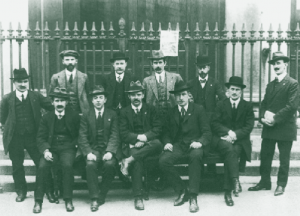
The national executive of the Irish Trades Union Congress and Labour Party in 1914, with James Connolly on the left beside William O’Brien (standing at the back); Jim Larkin is seated second from right. After the Lockout defeat Larkin and Connolly recognised that something more was needed.
In the short term, the Lockout was a pyrrhic victory for the employers. They did not abandon their central demand, the ban on Irish Transport and General Workers’ Union (ITGWU) members, but only its inspirer, Murphy, and a few others enforced it. The union was weaker but it survived. Its example inspired workers to organise themselves outside Dublin. In 1916 the Chamber of Commerce was to claim that the Rising was a revival of 1913 activism. For now, however, Dublin workers were weary. Their militancy would begin to revive only during the First World War, provoked by austerity and becoming general only from the end of 1917. Indeed, the tramway workers would not organise themselves successfully for twenty years. Less obvious than all this was the Lockout’s effect on the Labour leadership.
Labour leadership
This group recognised that the workers had suffered a serious setback. The question was, why? Part of the answer was obvious; once again, the strong, well-organised British unions had refused adequate support to a trade dispute fought by weaker Irish unions. (Even in Ireland, the British-based National Union of Railwaymen was organising the largest number of workers, not the ITGWU.) Most Irish Labour leaders accepted this as the whole story and responded by putting their faith in building their union organisations to limit dependence on their British comrades.
This should not be exaggerated. The majority of union leaders did not start thinking defensively. The Lockout itself had been, after all, a defensive fight. Nor did those with socialist perspectives abandon them. Rather, like too many of their comrades abroad, they assumed that socialism was inevitable but had no strategy developed to achieve it. Accordingly, they followed the prescription of their leading theorist, James Connolly, and sought to build an industrial republic (their unions) within the shell of the political state to a point where the unions would break out of that shell. Organisation was prioritised over agitation and education, the last being restricted to propaganda.
Larkin and Connolly
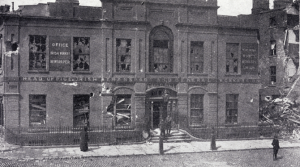
After the 1916 Rising, the ITGWU’s headquarters, Liberty Hall, was destroyed, its general secretary was in the USA, his replacement was executed and, for a month, its general president, Thomas Foran, was interned with other activists. (South Dublin Libraries)
Larkin and Connolly recognised that something more was needed. Connolly, the theorist, examined the problem of bureaucratic degeneration in the Scottish Forward and in his leaflet Old wine in new bottles. His choice of organ showed that he considered his Irish comrades to be inoculated against the British degeneration by their position in a colony, as, indeed, they were—just not enough. More generally, though in Old wine he insisted on the importance of maintaining militancy, he did not examine how this was to be done. Having experienced the political disagreements of self-styled vanguard parties, he had come to regard such parties as irrelevant.
More pragmatic, Larkin did see the need for working-class leadership distinct from the union structure. His choice was the Irish Citizen Army. This body attracted many advanced and often socialist trade unionists, but though it made them readier for a military struggle, it could not develop their consciousness as to how to prepare politically for one. In any case, the outbreak of world war and Larkin’s departure for America ended his attempt. The Citizen Army survived as, essentially, the ITGWU’s military arm. Connolly succeeded Larkin, becoming their union’s acting general secretary and army commander, preaching revolution openly and preparing it behind the backs even of his own comrades.
Perhaps had that planned moment been postponed the revolutionaries would have mobilised a much larger base in the working class to back a more explicitly socially radical programme than that on which the revolution would be fought. Such a postponement was barred on several points. Nobody knew that the war could linger until 1918. Connolly knew that he was one (perhaps the only one) of the Socialist International’s upholders of its 1907 Stuttgart Congress resolution that directed socialists to seek to use the dissatisfaction created by wartime conditions as fuel for revolt. Moreover, such dissatisfaction was accelerating the revival of militancy among the Dublin workers, particularly the strategically important dockers employed by the Dublin Steampacket Company. In the middle of their dispute, the IRB’s military committee presented Connolly with the ultimatum that it would rise with or without him.
The Easter Rising
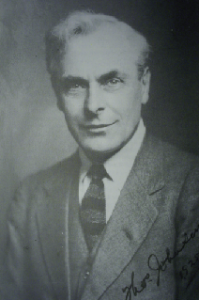
Thomas Johnson, later leader of the Labour Party in the Irish Free State. During the First World War he was a reformist and a pacifist, seeking peace without victory for either side and favouring, of the two, the United Kingdom and its allies.
The Rising made Connolly a bigger name than Larkin for the surviving ITGWU leaders to use to attract recruits. By 1920–2 the union was bigger than it would be again for three decades. Simultaneously, the Rising had magnified the existing negative qualities among union officials. Some were already hostile to the Citizen Army. The ITGWU’s headquarters, Liberty Hall, was destroyed, its general secretary was in the USA, his replacement was executed and, for a month, its general president, Thomas Foran, was interned with other activists. A subsequent general secretary, Michael Mullen, would later claim that a probably inquorate meeting of the union executive was held in the days after the insurgents’ surrender to deprive Connolly of his position and union membership. True or false, this reflected a real attitude, and it was stronger in other unions that did not have the Transport Union’s militant tradition.
This bias meant that, even had Connolly survived, he would have had major problems continuing his strategy. His death left nobody capable of defending it against ordinary trade union practice as underpinned theoretically when the combined ITUC and Labour Party met in Sligo in August 1916. The meeting was chaired by Thomas Johnson of the National Union of Shop Assistants. He was president of the Congress-Labour Party executive in which Connolly had been a first-time ordinary member. Connolly had complained about Johnson’s indecision when they were both in the Belfast branch of the propagandist Independent Labour Party of Ireland, but they collaborated in postponing the 1915 Congress-Labour Party meeting to 1916, fearing, with good reason, that pro-war delegates would have a majority if it met as scheduled.
This tactical agreement had obscured the strategic difference between them: Connolly was a revolutionary and a defeatist, seeking to execute the Stuttgart resolution and sabotage the United Kingdom war effort; Johnson was a reformist and a pacifist, seeking peace without victory for either side and favouring, of the two, the United Kingdom and its allies because, as he said in his Sligo presidential address, ‘France is still a republic—more firmly established’. (He did not mention Britain’s third major ally, Tsarist Russia.) To Labour he offered a perspective to
‘. . . create a strong party with a practical programme of social reconstruction, with democracy—political and social—as an ideal and a method. An intelligent advocacy of such a programme and its application by public bodies wherever possible will be the surest way of rallying the workers of Ulster to the banner of a united Ireland—free, democratic and self-governing.’
This formulation left room for mistakes. First, Johnson’s ‘strong party’ was a strengthened Congress-Labour Party, not even an independent labour body. This was particularly egregious in that the Irish workers made up less than half the working population; the balance was composed of small farmers, for whom Johnson’s ‘practical programme’ of agricultural co-operation was acceptable only by example. Second, while the whole idea of drafting and presenting ‘a practical programme of social reconstruction’ was useful, its fulfilment was presented as strictly electoral; although Johnson defended the right of workers to strike, for him state power was to be achieved only through the ballot box (a reversal of Connolly’s position). Third, this was the greater defect in what was the developing revolutionary situation from 1916. Fourth, in connection with this, there is no mention of the motor of that situation, the Irish national question; ‘the workers of Ulster’ is the nearest it gets. This was, perhaps, natural only a few months after the Rising, with many still interned, but it reflects a deeper prejudice shown in the speech’s link of insurgents and British Army recruits as equally worthy of honour and attacking ‘the national habit of mind’ as the cause of war. Again, Connolly was abandoned.
1918 general election
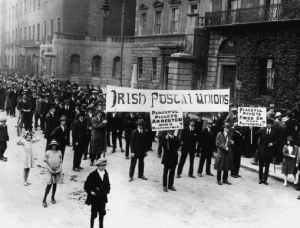
The heavy-handed tactics used against the postal workers’ strike of September 1922 demonstrated the irrelevance of Labour in the middle of a recession, with the employers mounting a counter-attack backed by the resources of the two states. (Irish Labour History Museum)
Johnson’s listeners were happy to overlook his departures from the dead theorist. They continued to work determinedly to fulfil Connolly’s directive in Johnson’s spirit. The industrial state was to be built until it smashed the shell of the political state, presumably by mobilising its own citizens’ votes at the ballot box in alliance with the small farmer co-ops. No short cuts were possible. In April 1917, Connolly’s closest ally of his last years, William O’Brien, was elected to a committee chaired by Count Plunkett to organise the political leadership of the reviving national revolutionary movement. O’Brien’s Labour comrades made it clear that he would compromise his trade union position by this membership and he resigned from what was to be the organiser for the new Sinn Féin. The Citizen Army was frozen out of Liberty Hall. In 1918, with both Republican and Labour movements growing and having organised a general strike against conscription, O’Brien was proposed as anti-conscription candidate in the Cavan East by-election, a nomination he refused, leaving the seat to be won by the right-wing Sinn Féiner Arthur Griffith. Accordingly, in the subsequent general election Labour’s small political clout meant that it had to choose between accepting Sinn Féin’s terms tying it to membership of the prospective Dáil Éireann or not contesting nationalist seats; it chose the latter. In the Anglo-Irish War after 1919, there were several effective work stoppages in support of Republican demands, but they were all initiated under pressure from the rank-and-file. Labour’s leaders proceeded according to the dictum ‘hasten slowly’; unfortunately, history had accelerated to overtake them.
‘Today we settle everything by negotiations’
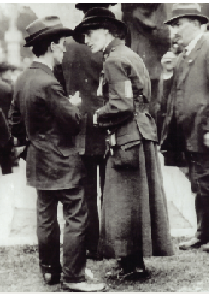
Countess Markievicz (with James Connolly behind her). Because she was a Labour sympathiser, de Valera made her minister for labour in the first Dáil’s underground government.
This was more than just avoiding the national issue, as is shown by their record in workplace disputes. Militancy in these was stimulated by the militancy shown in the strikes on the political front. The newly organised workers mobilised to gain what was owing to them. Their leaders serviced their activism with reasonable efficiency, but the ITGWU president, Thomas Foran, expressed his view in his remark, ‘Today we settle everything by negotiations’. Labour could not negotiate its way into state power, and its leaders would not seek it.
Sinn Féin sought to stop Labour doing so. In early 1918, the Irish Party MP Joseph Devlin, backed by the Freeman’s Journal, accused Eamon de Valera of ordering that ‘Labour must wait’. This campaign did not survive nationalist Ireland’s need to unite against conscription, but the smear lingered. Actually, Sinn Féin’s (and de Valera’s) approach to Labour was more subtle: to absorb or neutralise, but not to commit too far. The Irish Party’s attack was prompted by de Valera’s assurance that, under the Republic (interpreted by the Home Rulers as only under the Republic), Labour would have its full rights. Sinn Féin stressed its dedication to the 1916 Proclamation (including Connolly’s social aspirations) and to the utopian socialism of George Russell’s The national being, involving the peaceful, agreed replacement of capitalism by co-operation. It bargained with Labour over the 1918 general election. In exchange for promised international socialist support, it unanimously adopted the first Dáil’s ‘Democratic Programme’. De Valera made the Labour sympathiser Constance Markievicz minister for labour in the first Dáil’s underground government.
Sinn Féin’s social policies
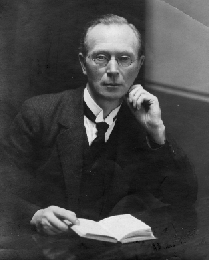
Eoin MacNeil (below) headed economic ministries, which he knew he was unable to administer, in order to pontificate on Connolly’s vision of Celtic socialism, translating it into a concept of communal class collaboration. (Lissadell House and Gardens, Sligo; UCD Archives)
But what were Sinn Féin’s projected concrete social changes? The party declared these at its re-founding convention in November 1917. It adopted a number of Labour-supported minimum demands: equal rights for women, a living wage (without mention of who would decide it), the control of food exports to prevent famine (a practical excuse for a series of arms raids and abandoned when they were completed) and the end of the Poor Law. The other motions passed were simply bourgeois nationalist, although with a strong statist support. Later, in America, de Valera would continue this ambivalence, balancing a qualified defence of the Bolsheviks, in Chicago, with a denunciation, to the Irish-American mine bosses of Butte, Montana, of Larkin as having tried to help proselytise Catholic children in 1913. Meanwhile, Eoin MacNeil headed economic ministries, which he knew he was unable to administer, in order to pontificate on Connolly’s vision of Celtic socialism, translating it into a concept of communal class collaboration.
By the time of the truce with Britain in July 1921, Sinn Féin was the sole Irish challenger for state power. Labour was now irrelevant and in the middle of a recession, with the employers mounting a counter-attack backed by the resources of the two states. Whether a more aggressive strategy would have given it the advantage can never be known for sure. Certainly this would have required a leadership of greater consciousness than that accepted by Connolly or, before America, by Larkin. As it was, Irish Labour did wait, and has waited, as a class, ever since. HI
‘Benevolent employer in the Quaker tradition’?
The factory opened its Dublin operation in 1851, and by 1911 it employed approximately 3,000 workers. George Jacob, chairman from 1902 to 1931, is remembered in the Dictionary of Irish Biography as a ‘benevolent employer in the Quaker tradition’ who was ‘ahead of his time with employee-focused reforms’. Yet unlike George Cadbury or Arthur Rowntree in Britain, Jacob paid low wages and his Quakerism did not prevent him from profiting from war: he supplied biscuits to the British army. These policies made the factory a frequent target of the labour newspaper The Irish Worker and its successor, James Connolly’s Workers’ Republic.
D.R. O’Connor Lysaght is the author of The Great Irish Revolution (2006), a series of criticisms of popular assumptions about the event.
Further reading
C. Kostik, Revolution in Ireland, 1913–1923 (Cork, 2009).
D.R. O’C. Lysaght, ‘Labour must wait: the story of a myth’, Saothar (2001).
A. Mitchell, Labour in Irish politics, 1890–1930 (Dublin, 1974).
















